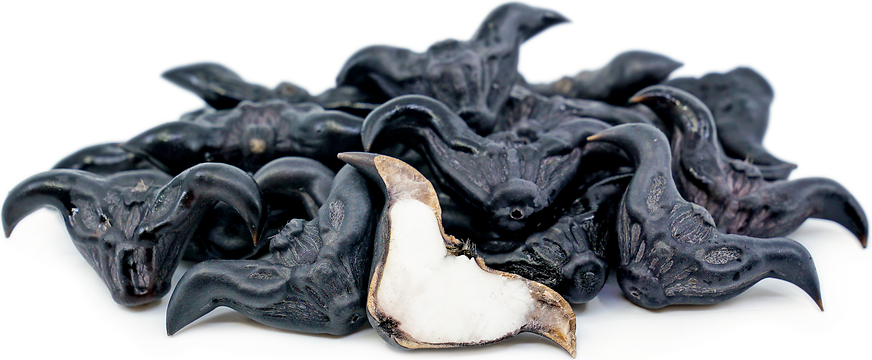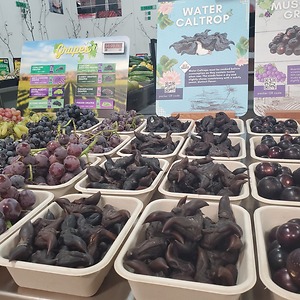


Water Caltrop
Estimated Inventory, lb : 0
This item was last sold on : 10/26/24
Description/Taste
Water Caltrops are irregularly shaped pods, averaging 5 to 7 centimeters in diameter, and have a tapered shape with two elongated and curved, drooping spines. The aquatic pods grow at the water's surface, just below a floating rosette of leaves, and have a tough and very hard exterior. They also have an unusual, rustic and earthy odor. The pods mature from green to dark purple-black and have a smooth surface with shallow indentations. Inside the pod, there is a large, singular and fibrous, white seed. Water Caltrops must be cooked as they are considered toxic when raw. After cooking, the pods are still very hard and can be cracked open to reveal the crumbly, starchy seed. Water Caltrop seeds have a dry and slightly chewy consistency with a subtly sweet, distinct flavor reminiscent of musk and hay.
Seasons/Availability
Water Caltrops are available in the late summer through fall.
Current Facts
Water Caltrops, botanically a part of the Trapa genus, are the seeds of an aquatic plant belonging to the Lythraceae family. There are three main species that are generally labeled as Water Caltrop in fresh markets, and each species has varying appearances with a hard pod and long, pointed spines. The pods featured in the photograph above belong to the Trapa bicornis species, which bears two distinct spines and is native to regions of Asia. Trapa bicornis pods are known by many names, including Bat Nut, Ling Nut, Devil’s Pod, Chinese Horn Nut, and Singhada, and the shape of the nut is often described as similar to a flying bat or bull’s face. Throughout Asia, Water Caltrops are found growing in calm areas of water such as lakes, ponds, and rivers, and are also cultivated on a small scale in floating fields. The pods are considered somewhat rare, as they are only in season once a year, and are favored as a street snack, traditionally boiled or roasted.
Nutritional Value
Water Caltrops are an excellent source of minerals, including calcium, iron, zinc, and phosphorus, which contribute to healthy bone development, strengthen the immune system, and boost overall vital functions of the body. The seeds are also a good source of fiber to stimulate the digestive tract and contain iodine and manganese, which help keep the thyroid gland working properly. In traditional Chinese medicine, Water Caltrops are used to cleanse the body and are considered to be a neutral, nonaggressive remedy.
Applications
Water Caltrops must be cooked before consumption as they contain toxins when raw. The hard, spiny pods are primarily boiled in salted water, and once cooked, the pods are cracked open to reveal a crumbly and dry, white seed. It is also important to note that the pod's musky, hay-like odor will become more pronounced as the pod is being boiled. Cooked Water Caltrops can be eaten as a stand-alone snack, sometimes lightly salted, or they can be mixed into stir-fries, stuffed into dumplings, or stirred into rice and vegetable dishes. The seeds can also be roasted and are a favored street food in Taiwan. In addition to whole preparations, Water Caltrops can be dried, ground into a flour, and used to make flatbread, fritters, pancakes, desserts, porridges, and liquor. In India, Water Caltrop flour is traditionally consumed in special meals on fasting days as a cleansing agent for the body. The starchy seeds can also be candied or preserved in honey and sugar for extended use. Water Caltrops pair well with salt, spices such as cumin, cardamom, and coriander, tulsi leaves, nuts such as peanuts, cashews, and almonds, broccoli, snow peas, carrots, bell peppers, and potatoes. Whole, uncooked Water Caltrops will keep up to one week when stored in a ventilated plastic bag in the refrigerator. Cooked and deshelled seeds will keep for a couple of days when stored in a sealed container in the fridge. The seeds can also be frozen.
Ethnic/Cultural Info
Water Caltrops are one of the traditional foods consumed during the Mid-Autumn Festival in Asia. The annual event is held in the fall, according to the lunar calendar, and is celebrated throughout Eastern Asia. Each country has its own method of celebrating, and in China, the festival is closely associated with family reunions, being the second most important holiday besides Chinese New Year. During the Mid-Autumn Festival, specific food items are consumed to bring health, luck, and fortune. Water Caltrops are known as Ling Jiao in Chinese and are favored for their resemblance to a bat. The word bat in Chinese have a "fu" sound in it, which is similar to the sound of the word for luck. As a homonym, consuming Water Caltrops is believed to bring luck, and the boiled nuts are primarily eaten after mooncakes as a savory-sweet snack. The nuts are also used as decorations, strung onto garlands, and in some regions, the pods are used to make necklaces.
Geography/History
Water Caltrops are native to Asia's temperate and tropical regions, where they have been growing wild for over 3,000 years. The three main species are found in calm bodies of freshwater and are also cultivated in flooded fields throughout Eastern Asia. In ancient times, Water Caltrops were also present in Europe, where they were roasted and sold as a street snack. Over time, the Water Caltrop populations dwindled in Europe due to habitat loss and mostly disappeared in the late 19th century. In 1874, the aquatic plants were introduced to the United States, where they quickly became known as an aggressive invasive species in waterways along the East Coast. Today Water Caltrops are primarily found in India, China, Vietnam, Cambodia, and Laos and have been naturalized in Australia and the United States. When in season, the spiny pods are sold through local farmer's markets and Asian grocers
Recipe Ideas
Recipes that include Water Caltrop. One
| NDTV Food |
|
Singhare Atte Ki Barfi Recipe |
| Vedics |
|
Singhare (Water Caltrop) Ki Kachori |
| NDTV Food |
|
Paneer Tikki Recipe |
| Messy Witchen |
|
Boiled Caltrops |
| The Hong Kong Cookery |
|
Boild water Caltrop |














